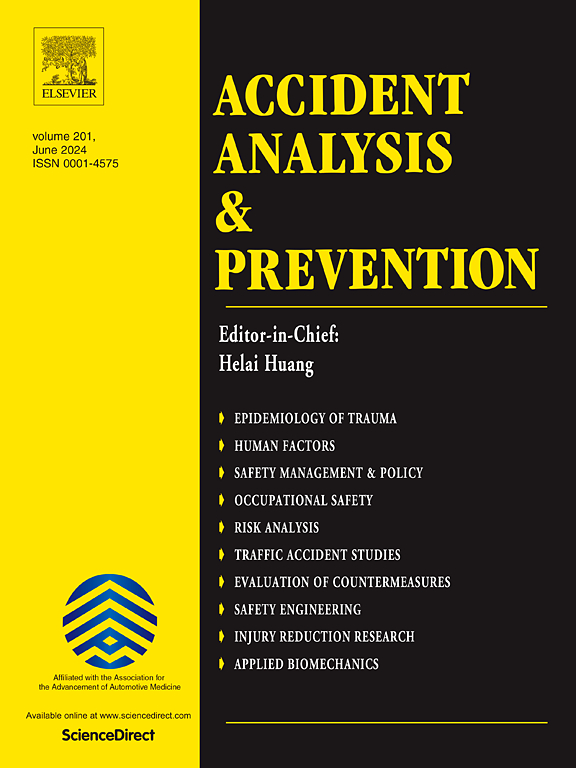Directional vibrotactile takeover requests on a wrist-worn device: effects of age, pattern type, and urgency in automated driving
IF 6.2
1区 工程技术
Q1 ERGONOMICS
引用次数: 0
Abstract
Drivers are still required to perform the takeover task in highly automated vehicles. This task, which is cognitively and physically demanding, may present challenges for older adults due to general age-related declines in perception and cognition. Tactile modalities that may not be occupied by many non-driving-related tasks could serve as a potential solution for delivering takeover requests. Among these, directional vibrotactile stimuli presented via a wrist-worn device represent a promising approach. However, the effects of the two common types of directional vibrotactile patterns, dynamic patterns that vibrate sequentially at different locations and static patterns that vibrate at fixed locations, are still unknown. Therefore, this study aimed to investigate the effect of age (younger and older adults), vibrotactile pattern types (Baseline, Full-Dynamic, Semi-Dynamic, and Static), and interpulse interval (shorter (300 ms) and longer (800 ms)) on takeover performance. Forty participants (20 younger and 20 older adults) were engaged in the SAE Level 3 driving simulator study. Overall, Static and Baseline patterns were associated with faster reaction and takeover times and were perceived as more useful and satisfactory compared to the Full-Dynamic and Semi-Dynamic patterns. Shorter interpulse intervals (300 ms) for vibrotactile takeover requests resulted in better takeover performance, as indicated by shorter reaction and takeover times compared to longer interpulse intervals (800 ms). Finally, younger adults reacted faster to vibrotactile takeover requests than older adults did. The findings from the current study may inform the design of human–machine interfaces on wearable devices for next-generation automated vehicles.
腕带设备上的定向振动触觉接管请求:自动驾驶中年龄、模式类型和紧迫性的影响
在高度自动化的车辆中,司机仍然需要执行接管任务。这项任务对认知和身体都要求很高,由于感知和认知能力普遍随着年龄的增长而下降,可能会给老年人带来挑战。触觉模式可能不会被许多与驾驶无关的任务占用,可以作为传递接管请求的潜在解决方案。其中,通过腕戴设备呈现的定向振动触觉刺激代表了一种很有前途的方法。然而,两种常见的定向振动触觉模式,即在不同位置连续振动的动态模式和在固定位置振动的静态模式的影响仍然未知。因此,本研究旨在探讨年龄(年轻人和老年人)、振动触觉模式类型(基线、全动态、半动态和静态)和脉冲间隔(短(300 ms)和长(800 ms))对接管行为的影响。40名参与者(20名年轻人和20名老年人)参与了SAE 3级驾驶模拟器的研究。总的来说,静态和基线模式与更快的反应和接管时间有关,与全动态和半动态模式相比,它们被认为更有用,更令人满意。与较长的脉冲间隔(800毫秒)相比,较短的脉冲间隔(300毫秒)对振动触觉接管请求产生了更好的接管性能,这表明较短的反应和接管时间。最后,年轻人对振动触觉接管请求的反应比老年人更快。目前的研究结果可能会为下一代自动驾驶汽车可穿戴设备的人机界面设计提供信息。
本文章由计算机程序翻译,如有差异,请以英文原文为准。
求助全文
约1分钟内获得全文
求助全文
来源期刊

Accident; analysis and prevention
Multiple-
CiteScore
11.90
自引率
16.90%
发文量
264
审稿时长
48 days
期刊介绍:
Accident Analysis & Prevention provides wide coverage of the general areas relating to accidental injury and damage, including the pre-injury and immediate post-injury phases. Published papers deal with medical, legal, economic, educational, behavioral, theoretical or empirical aspects of transportation accidents, as well as with accidents at other sites. Selected topics within the scope of the Journal may include: studies of human, environmental and vehicular factors influencing the occurrence, type and severity of accidents and injury; the design, implementation and evaluation of countermeasures; biomechanics of impact and human tolerance limits to injury; modelling and statistical analysis of accident data; policy, planning and decision-making in safety.
 求助内容:
求助内容: 应助结果提醒方式:
应助结果提醒方式:


